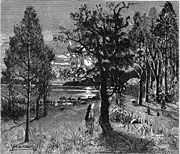
Sigrún
Encyclopedia


Valkyrie
In Norse mythology, a valkyrie is one of a host of female figures who decides who dies in battle. Selecting among half of those who die in battle , the valkyries bring their chosen to the afterlife hall of the slain, Valhalla, ruled over by the god Odin...
in Norse mythology
Norse mythology
Norse mythology, a subset of Germanic mythology, is the overall term for the myths, legends and beliefs about supernatural beings of Norse pagans. It flourished prior to the Christianization of Scandinavia, during the Early Middle Ages, and passed into Nordic folklore, with some aspects surviving...
. Her story is related in Helgakviða Hundingsbana I
Helgakviða Hundingsbana I
Völsungakviða, Helgakviða Hundingsbana I or the First Lay of Helgi Hundingsbane is an Old Norse poem found in the Poetic Edda...
and Helgakviða Hundingsbana II
Helgakviða Hundingsbana II
Völsungakviða in forna, Helgakviða Hundingsbana II or the Second Lay of Helgi Hundingsbane is an Old Norse poem found in the Poetic Edda...
, in the Poetic Edda
Poetic Edda
The Poetic Edda is a collection of Old Norse poems primarily preserved in the Icelandic mediaeval manuscript Codex Regius. Along with Snorri Sturluson's Prose Edda, the Poetic Edda is the most important extant source on Norse mythology and Germanic heroic legends, and from the early 19th century...
. The original editor annotated that she was Sváfa
Sváfa
In Norse mythology, Sváfa or Sváva is a valkyrie and the daughter of king Eylimi. Consequently she was probably the maternal aunt of Sigurd, the dragon slayer, although this is not explicitly mentioned in Helgakviða Hjörvarðssonar where Sváfa's story appears.-Etymology:The etymology of the...
reborn.
The hero Helgi Hundingsbane
Helgi Hundingsbane
Helgi Hundingsbane is a hero in Norse sagas. Helgi appears in Volsunga saga and in two lays in the Poetic Edda named Helgakviða Hundingsbana I and Helgakviða Hundingsbana II. The Poetic Edda relates that Helgi and his mistress Sigrún were Helgi Hjörvarðsson and Sváva of the Helgakviða...
first meets her when she leads a band of nine Valkyries:
|
|

Högne
For other people named Högne, see Haguna.Högne was a king of Östergötland who appears in sources Norse mythology.-Heimskringla:Snorri Sturluson wrote that he was the king of Östergötland and that he had a son named Hildur and daughter Hilda who was married to Granmar, the king of Södermanland...
has promised her to Höðbroddr, the son of king Granmar
Granmar
Granmar was a king of Södermanland, in Snorri Sturluson's Heimskringla. The same king also appears in the Volsunga saga.Granmar was married to Hilda, the daughter of the Geatish king Högne of East Götaland, and his son-in-law was the seaking Hjörvard of the Ylfings...
r. Helgi invades Granmar's kingdom and slays anyone opposing their relationship. Only Sigrún's brother Dagr is left alive on condition that he swears fealty to Helgi.
Dagr is however obliged by honour to avenge his brothers and after having summoned Odin
Odin
Odin is a major god in Norse mythology and the ruler of Asgard. Homologous with the Anglo-Saxon "Wōden" and the Old High German "Wotan", the name is descended from Proto-Germanic "*Wodanaz" or "*Wōđanaz"....
, the god gives him a spear. In a place called Fjoturlund, Dagr kills Helgi and goes back to his sister to tell her of his deed. Sigrún puts Dagr under a powerful curse after which he is obliged to live on carrion in the woods.
Helgi is put in a barrow
Tumulus
A tumulus is a mound of earth and stones raised over a grave or graves. Tumuli are also known as barrows, burial mounds, Hügelgrab or kurgans, and can be found throughout much of the world. A tumulus composed largely or entirely of stones is usually referred to as a cairn...
, but returns from Valhalla one last time so that the two can spend a night together.
Sigrún died early from the sadness, but was reborn again as a Valkyrie. In the next life, she was Kára
Kára
In Norse mythology, Kára is a valkyrie. Kára is attested in the prose epilogue of the Poetic Edda poem Helgakviða Hundingsbana II. The epilogue details that "there was a belief in the pagan religion, which we now reckon an old wives' tale, that people could be reincarnated," and that the deceased...
and Helgi was Helgi Haddingjaskati
Helgi Haddingjaskati
Helgi Haddingjaskati meaning "Helgi the lord of the Haddingjar" was a legendary Norse hero of which only fragmentary accounts survive.It is said in the end section of Helgakviða Hundingsbana II, a part of the Poetic Edda, that the hero Helgi Hundingsbane and his lover Sigrún were reincarned as...
, whose story is related in Hrómundar saga Gripssonar
Hrómundar saga Gripssonar
Hrómundar saga Gripssonar or The Saga of Hromund Gripsson is a legendary saga from Iceland. The original version has been lost, but its content has been preserved in the rímur of Hrómundr Gripsson published in Fernir forníslenzkar rímnaflokkar...
.

